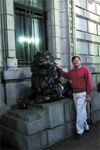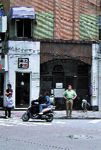Article
An ophthalmologist retraces his roots in Shanghai
The floor tiles have not changed in 56 years. As soon as I see the brick-red, black, and green-grey pattern of the 3/4-inch squares, recollections of a time long past rise to the surface. Even before I walk up the steps in the small lobby, my legs remember that there will be six risers to the landing in front of the elevator.

During the first week of April 1933, my father, Max Dahl, MD, a trained psychiatrist who worked as a general practitioner, returned from his Italian honeymoon with his new wife to resume his successful medical practice in Ludenscheid, Westphalia, Germany.

Since my father was receiving payment for patient care from the central German social insurance program, he was considered a civil servant. The imposed boycott and this new law essentially terminated his medical practice.
My father and his 23-year-old bride decided to go to Shanghai, despite protestations from their families that China was at the end of the Earth. The United States was in a deep depression and many other countries had strict immigration policies.
Shanghai was an open city, where no visa was needed for entry and where there was already a thriving international community of British, French, Russians, and Americans who had arrived in the prior 50 years.
My parents' adventure in Shanghai, which was supposed to be only a brief interlude until Germany came to its senses and re-established itself as a Republic, lasted 16 years. My father established a medical practice on Kiukiang Road (now Jiujiang Lu) near the Bund and cared for both international and Chinese patients.

My father presided at my delivery at the Shanghai Country Hospital (now Shanghai First People's Hospital) a few weeks before the Japanese attack at Pearl Harbor. The Japanese had occupied Shanghai in 1939 but apart from poor economic conditions, my parents were left alone through the end of the war. Many other refugees lived in the poorer Hongkou sector (across Suzhou Creek).
In 1943, that area was made into a restricted ghetto and all stateless refugees who had arrived after 1937 were forced to move residences and businesses into a one-square-mile area in Hongkou known as the Jewish ghetto. It was my family's good luck to be considered long-time residents of Shanghai and be spared that experience. My father was also able to bring his parents from Europe to live with us. My mother's family was not so fortunate-a large number were killed in Auschwitz and other extermination camps. My first taste of chocolate was provided to me by an American soldier walking in the street in late 1945.
Newsletter
Don’t miss out—get Ophthalmology Times updates on the latest clinical advancements and expert interviews, straight to your inbox.




